This will highlight the first exposure to Micro Seiki 8000 mkII with
- Ikeda 407 (with VTA lifter) with VDH Stradivarius and FR 64s with the Koetsus. The VDH has a body with Hawaiian Koa Wood and an old Stradivari type of lacquer
- The above compared on Zingalis with Airtight ATM 211 monos and Airtight ATE 2001 pre, and the YG Anat II reference professional with yes, 1000 Euro Hypex Ncore 400 monos and the Plinius M16 pre
- Koetsu Black Gold Line, Urushi Sky Blue, and the Onyx Platinum with Rosewood headshell and titanium headshell compared on the FR 64s
- Also the Micro Seiki direct drive DQX 1000 with the standard MA500 arm and an Ortofon 2M Bronze cart
- Thoress phono vs the built in phono in the Airtight pre
But first, an introduction to Juergen, known on various forums as Shakti. He is on WBF, and is also active on 2 German forums (http://www.analog-forum.de/ and https://www.open-end-music.de). I chanced upon him because he had a lot of experience with NAT amps – he has been through their various SET models, and as I would later learn, through KR and Airtight as well. Speaking to him and exchanging messages, we both pleasantly surprised each other being comparophiles in arms – he runs regular workshops where people bring along gear and he runs them through compares. His gear is beautifully set up for shootouts, and he regularly churns in a methodical fashion to get perspectives on different gear.
You can click on each pic to expand
As I read through his German posts (use google translate), I noted that he was also a Lampi fan and was systematically rolling tubes in the Lampi to check which tube matched with which phono. He would set up his analog, then roll the tubes to try and best the analog or to check which tube sounded similar to a particular phono. If it got bested, he would then change the cart, or the phono setting, repeat. He would always have reference components to compare. At one time he had Thoress, Aesthetix IO Signature, and Kondo M7 with the SUT. He has owned the Schopper Thorens 124 before, which had bested the TTs he had then. And just to round it off, he loves Shun Mooks too.
More importantly, I also saw more maturity in comparisons because Juergen tries to see what is the best way to bridge the sonic differences between two components. How to tune a Koetsu to get more detail and highs like a colibri? Which tubes on the Lampi tubes would sound more like the IO, which would sound more like the Kondo? And when you read his posts, what you see is a methodical thought process and painstaking effort.
Unfortunately he had sold off most of his stuff when I had reached, so the Lampi, Aesthetix, and Kondo were no longer there. But there was the whole Microseiki collection – 500, 1000, 1500, 8000mk2, and he received the 5000 a day after my trip – he wanted to see how the gun metal platter sounds, as the 8000 has a stainless steel platter. I had been dying to hear a well set up Micro Seiki ever since David Karmelli told me about it, and that was almost two years ago, so this was my chance.
We started off getting a feel of the system, I played some CDs on his Oracle CD player, through the Airtight 211 with GE valves, Airtight Reference pre, and the Zingali client name speakers.
Then we moved to the MS 8000, with the Bruch Scottish Fantasia. With the VDH, the sound seemed a bit thin, less body to the violin. With the Koetsu Black, which is a metal bodied Koetsu, the soundstage was more, deeper, forward, wider, and more importantly, it was a whole. It was a whole, integrated sound, and balanced throughout.
I was surprised. Having heard the Koetsu Coralstone on a kuzma 4p against the Atlas, another one on an SME 30/12, a Koetsu Rosewood Signature against the Neumann on the American Sound (now where would that be), and a Koetsu Rosewood Platinum against the Zyx Uni 1, I was confident I did not like Koetsus at all, that they were soft and rolled off. And I had liked the VDH Strad on the schick plinthed Commonwealth in the WE room at Munich…probably the best analog playback in Munich this year. I have also heard it on the Blue Jem Pearl
So I put on the Beethoven Emperor by Rubinstein. I remembered Koetsu as less nuanced than the Zyx and the Ortofon and the Neumann on piano notes. I thought it would be similar against VDH. But no, here I again preferred the Koetsu by a clear margin. Cohesive and bigger soundstage, more body to the piano – sure, there was some more energy on the VDH on the higher frequencies on the explosive moments, but it was leading to an imbalance as the energy was not throughout the frequency spectrum.
Juergen then took off the EUR 2k Black and put the 5k Urushi, which is a wooden body. I did not hear any advantages in the Urushi, if anything, I preferred the Black, as did he. He then put on the Onyx, with a Rosewood headshell. This was in some ways similar to the Urushi, but a bit better. So Juergen changed to an Onyx with the Titanium headshell (Yamamoto HS5). Now the details in the Koetsu had leapt up to near VDH standards, there was more nuance, and more dynamism. We decided to keep the titanium on. The Onyx Platinum has silver coated wiring and a platinum supported magnet, and probably has more resolution than the normal Onyx. Both the Black and the Onyx with the Titanium headshell show more attack on piano as well.
Moving to Sceherazade, again it was quite black and white. The soundstage, the depth during the tympanis and the bass drums, the energy in the fourth movement, the tonal body of the Koetsu, all of this was much more enjoyable, and I cannot stress this enough, an integrated whole. Juergen used this term integrated and whole to describe the Koetsu on the forums and when I had read it I had glanced past it, but now I knew what it meant. The soundstage was just right, the diffuseness enough to make it real instead of hifi, a complete whole, well balanced. There is density across all dimensions, the whole soundstage space seems full. The trombones were fantastic and full bodied.
On the Argenta Espana, which gets extremely detailed, the VDH did show a bit more detail but the imbalance through the spectrum was showing
On Schubert’s Winterreise, the VDH did make it sound as if Peter Schreier was opening his mouth more, but overall the Koetsu was preferred. The Koetsu was also more emotional as was observed on every other track, and it made you want to play the LP more.
Moving to the YG Anat II
Moving from SETs and Zingali to YG with 1000 Euro Class D Hypex (Juergen has sold off his monstrous Krells), turned out to be a clear nod for a speaker first approach, because the YG with the Hypex was easily superior. It’s a better speaker. The midbass and the bass of the Anat was so much more and well balanced, that the music flowed more easily. YGs can get slightly metallic if not with the best amps, but yet with the class D, the Winterreise was better. I have previously heard and compared many amps on YG Hailey – Boulder 2160, Luxman m900u, Burmester 911 and 909, Nagra classic, Viola Symphony and Plinius. And Vitus SIA 025 and Berning Quads on YG Kipods. Of those, Luxman, Boulder, Vitus and Berning would sound better than the Hypex, the others I would not be so sure off without a direct compare.
And now, the VDH on the Winterreise did better than the Koetsu. I suspect this is because the midbass and bass was balancing the thinness of the VDH more, and the highs were better.
However on all the other LPs, we preferred the Koetsu, though the gap had narrowed. Probably the fullness of the Koetsu was no more so required due to the midbass and bass of the YG. Also, the YG could take more details than the Koetsu could give it. Yet the Koetsu had more flow and was more natural.
We did more compares of headshells, changing carts for every track on Scheherazade, Emperor, and Schubert’s Winterreise. As mentioned for reasons previously stated, both of us preferred the Black (the cheapest of the lot at 2k Eur), and the most expensive, Onyx, with the Titanium headshell. The Urushi costs 5k Eur retail. On the vocals the Onyx with the Rosewood headshell seemed marginally more involving, though the titanium was cleaner, but everywhere else the Black and the titanium seemed consistent. Juergen also suggests Nishikawa’s titanium headshell with a titanium connector (the others including his have a non-titanium connector). The Nishika one is more expensive at 2500 USD.
This was my second time with the FR 64s, the previous time was with Zyx Uni 2 on the Schopper TD 124. Both times I loved it, great energy, bass punch, stage, musicality. I have compared the Ikeda to the Thales on a Feickert Firebird with the Zyx Uni 1 and loved the Ikeda as well. Juergen suggested that Koetsu sounds best in undamped arms, and not in damped modern arms. He therefore prefers it in his FR 64 vs the Ikeda which is damped. He prefers the VDH in damped arms and his is tuned to the weight of the Ikeda. His FR 64 has a silver cable, Big “bass resonator” screw, similar to B60 VTA lifter. He has several screws and rubber rings that he uses to tune the arms.
The MS 8000 sounds completely different depending on the cart you have on it. With the Koetsu it was well balanced, great bass and midbass without any hump, full bodied, musically engaging. Juergen has experimented with active platforms including Herzan TS 140, but prefers the MS base for a natural synergy. Knock on it while playing and you cannot hear anything
Microseiki Direct Drive DQX 1000 with the standard MA500 arm and an Ortofon 2M Bronze cart
Now, this is the surprise of the evening. We put on the direct drive Microseiki 1000, with the Mircoseiki Arm, and an Ortofon 2m Bronze MM cart. The whole package will cost you between 1500 – 2000 Eur. IT WAS FANTASTIC. What stable piano, great soundstage and dynamics, probably because of the higher output of the MM cart. We heard all the LPs on it and enjoyed them. Moving back to the 8000, yes it was better, more of everything, more musical detail, more soundstage, but the MS 1000 IS A STEAL. It also has a great nice soundstage and depth, just not as wide and as deep. Straight to the recommended list. The beauty of analog. You can walk away from a better sounding component being satisfied with the lesser sounding one, will never happen in digital.
This is enough to keep anyone sonically satisfied. Loads of stage, drive, torque, stability, musicality. Would like to hear this with an FR 64 and a Koetsu or a Zyx or Ortofon a95 to see how it steps up on detail. Though not required. But yes, we ran through our LPs again quickly on both speakers. It is quite amazing how MS has trickled down their technology to the lower models.
Thoress vs the built-in Airtight on MM
The final compare was between the Thoress which had been in play all along, and the built in phono of the airtight reference preamp. I had greatly preferred the Airtight ATE 2005 to a 2.5 times priced Music First phono with Kuzma Stabi M and Transfiguration Proteus. However, we could only do this compare with the MS 100 and the MM cart.
Comparing the two, the Thoress was more full bodied, and whole and integrated. The built in Airtight phono seemed a tad more dynamic and analytical, more flatter on the front and back plane, towards the speakers. Juergen reckons the MM section here is the analytical one and with an MC the tonal balance is better.
But overall, this was a great lesson in seeing how deftly one can change headshells and have the whole set up planned and organized. Juergen is extremely methodical and has set up stuff so that he can swap quickly during his regular workshops. His views are balanced, no favoritisms, but measured compares. He keeps two systems to get different perspectives. Do follow his posts and threads, and keep an eye on his gear as sooner or later he will be letting go something you yearn for.
For details on Juergen’s thought process on how he set up these carts on his MS, you can read this WBF thread
Oh, and I forgot to take pics of his Home Theatre room and a smaller room with 2 NAT SE amps and a small horn

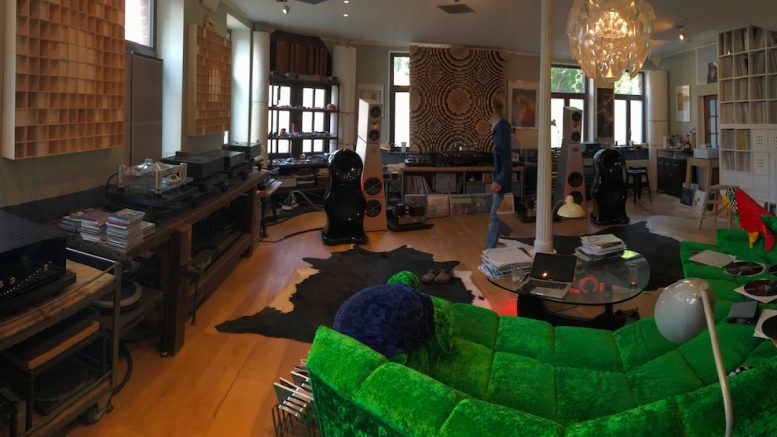

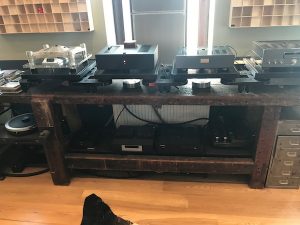
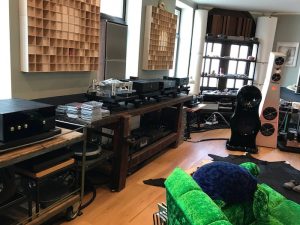
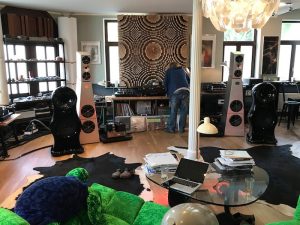
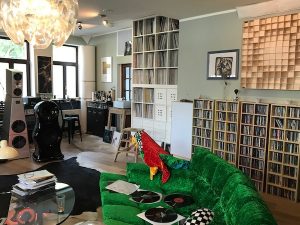
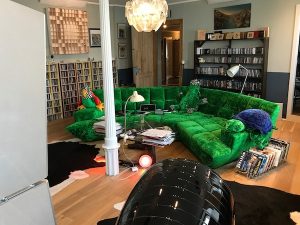
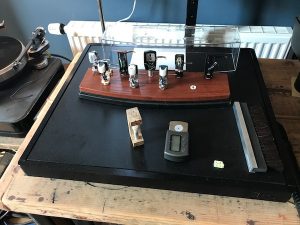
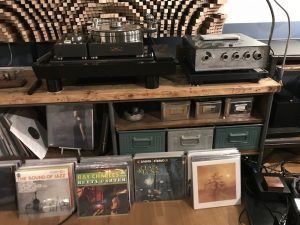
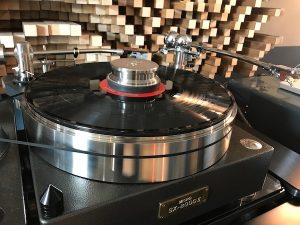
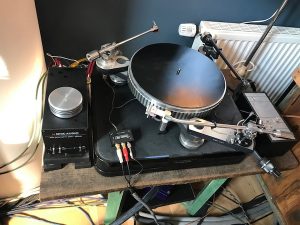
Be the first to comment on "Micro Seiki 8000 mkII, Koetsu, Colibri, Thoress, Airtight"